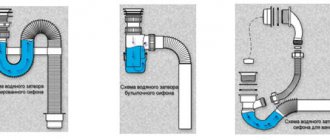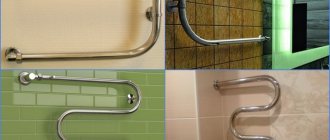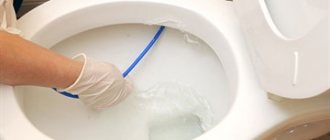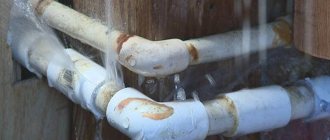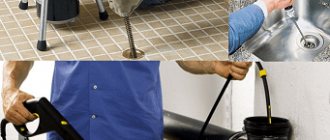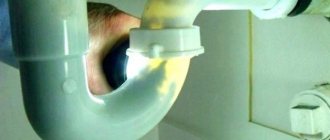An unpleasant smell from pipes in the bathroom is a phenomenon familiar to everyone. Often, even the highest quality and strongest air fresheners do not help eliminate the smell.
The stench from the sewer is a consequence of certain problems in the operation of the system. In the bathroom, sterile cleanliness should be combined with a good aroma, which indicates the neatness of the owners.
Before you can finally get rid of the smell, you need to eliminate the cause of its appearance. It is not enough to simply spray the product; the issue will not be resolved this way.
Experts recommend considering all options, finding out the source of the problem and eliminating it.
Where did the sewer smell come from in the bathroom?
Before looking for the cause of an unpleasant odor, you need to determine its source. It could be:
- Drain hole in the sink;
- Bathtub drain;
- Overflow hole;
- Water pipes.
Determining the source of the odor is easy. You'll just have to "sniff" the bathroom. Where the smell of sewage is more pronounced, there are problems. Below we will look at the reasons for the appearance of sewer odor in the sink, bathtub and water pipes.
Important
If you can't pinpoint the source of the sewer odor, check your ventilation. With poor exhaust ventilation, gas (odor) spreads throughout the entire volume and it is difficult to find its source. The easiest way is to ventilate the bathroom, and then look for where the sewer smell is coming from.
Why does my bathroom sink smell like sewer?
There are 5 reasons for the smell of sewage coming from your bathroom sink. Let's look at them in order and tell you how to solve the problem.
Reason #1 – sewer smell after replacing a sink
If an unpleasant odor appears immediately after installing or replacing a sink, in 99% of cases it is a lack of siphon or water seal. There are several reasons:
- Forgot to install;
- There was no siphon at hand;
- Incorrect water seal.
A siphon (hydraulic seal) is a structure that creates a plug of water. It prevents sewer gases from entering the bathroom. There are three types of siphons:
- Bottle;
- Tubular;
- Corrugated.
Types of siphons: 1 - bottle; 2 - tubular; 3 - corrugated.
The only solution to the problem is to install a water seal. It's easy to do it yourself. The optimal solution is a bottle siphon. It takes up minimal space. If this is not possible and there is space under the sink, you can install a corrugated siphon - this is the cheapest option.
Reason No. 2 - plaque on pipes
Over time, deposits can build up on your pipes. They emit a mixture of gases that give off a so-called sewer smell. You can identify them visually - just look into the hole in the sink.
This problem occurs only when a tubular or corrugated water seal is installed. The farther it is from the drain hole, the greater the likelihood of an unpleasant odor, its strength and speed of intensification. This is due to the fact that a large length of pipes remains dry after using the sink.
Getting rid of an unpleasant odor is easy. You can clean the water seal mechanically - with a sponge or brush with detergent. The second option is to fill in a special liquid to clean the pipes from plaque and dirt. Here are the best remedies:
- Chirton "Clean Gutters";
- Deboucher;
- Baghi Pothan;
- Sanoks "Clean drain";
- Mole;
- Selena Anticlog.
Important
Sometimes the drain is made entirely of corrugated pipe. Over time, plaque forms in the grooves of the corrugation, which is difficult to clean. The best option is to make a drain from pipes with smooth walls. Corrugated ones can only be used as a water seal.
Reason No. 3 - siphon clogging
This happens when a bottle-type siphon is installed under the sink. Over time, dirt accumulates in it, which settles at the bottom. Its layer grows and can reach the edges of the vertical tube.
The condition of the siphon can only be determined by removing the bottom cover. It is mounted on a thread, often with a rubber or plastic gasket. This lid is also the bottom of the siphon. It is advisable to clean it periodically. The frequency of cleaning depends on:
- Siphon volume;
- Intensity of use of the sink;
- Water quality;
- Detergents used.
Reason No. 4 – drying out of the water seal
A bad smell from the drain hole may appear if the water in the water seal has evaporated. In this case, nothing will prevent gases from the sewer from flowing into the bathroom. There may be two reasons for drying out:
- You haven't used the sink for a long time;
- The temperature in the bathroom is high.
In the first case, everything is simple - turn on the tap for 5-10 seconds and the siphon will fill with water. In the second case, there are two solutions. If the bathroom has a heated floor, heater or radiator, reduce their temperature. When it is not possible to lower the temperature, wrap the siphon and all pipes leading from the sink to the drain with thermal insulation.
Reason No. 5 - incorrect installation of the bottle siphon
The design of the bottle siphon is simple. The vertical pipe must be immersed in water, which prevents gases from entering the bathroom from the pipes. Some siphons have a solid body; in others, the immersion level of the pipe can be adjusted. If it does not reach the water level, there is no obstacle to the passage of sewer gases.
Installation and height adjustment of a bottle-type siphon.
Why does my bathtub smell like sewer?
The second most common source of unpleasant odor is the drain hole in the bathroom. In this case, there are 5 main problems, which we will discuss below. So, let's figure out why the bathtub smells like sewage and what to do?
Reason No. 6 – a large number of joints
Sometimes a bathtub drain is made from a large number of elements. Accordingly, there are joints between them. These are places where dirt accumulates and plaque forms. They can be sources of unpleasant odors. When connecting the bathtub to the sewer, follow the rule: the fewer elements, the better.
You can only discover that dirt has accumulated in the joints by disassembling them. But even if it is not there, remake the drain system so that it has a minimum of pipes, elbows and couplings. This is a good preventative against unpleasant odor.
Blue lines indicate joints where dirt can accumulate. In this case there are 10 of them. This is too many for a short area.
Reason No. 7 - sagging drain pipe
Typically, the bathtub is positioned so that the drain is closer to the sewer connection. If it is located the other way around, they are connected by a long pipe. It may sag due to poor quality materials or improper installation. At the same time, dirty water stagnates in the place of sagging and dirt accumulates.
You can determine the sagging of the drainage pipe by eye. If in some place it is located horizontally, place a support under it so that it is located at an angle along its entire length. This will ensure normal water drainage from the bathtub.
Reason No. 8 – incorrect slope of the drainage
If, as in the previous case, the bathtub drain hole is located far from the entrance to the sewer, they are connected by a drainage pipe. It should be located at an angle so that water and dirt do not stagnate. If the angle is insufficient, there is a possibility that a sewer smell will appear in the bathroom.
Important
The slope must be at least 3 cm for each linear meter of pipe. But the more, the better. This also applies to other elements - corners, tees.
As a rule, insufficient pipe slope is caused by leaving too high a vertical part of the pipes near the drain or sewer. The fix is easy - make these parts as short as possible. If the bathtub is installed low, then the only option is to raise it.
In this case, the drain pipe is not installed correctly. It is not even located horizontally. The slope goes towards the drain hole, not away from it.
Reason No. 9 – connection without a water seal
As in the case of a sink, the bath drains through a water seal. Sometimes it is implemented initially, in the form of an S-shaped elbow of a cast iron sewer pipe. In other cases, a siphon is made when installing and connecting the bathtub. It comes in three types:
- Bottle;
- Tubular;
- Corrugated.
If there is no water seal, gases from the drain will flow into the drain. This will cause the bathroom to smell like sewer. The problem can only be solved by installing a water seal. Its type must be chosen based on the distance between the bathroom and the floor. At the same time, do not forget that you need to maintain the slope of the drain pipe.
Reason #10 – horizontal drain elements
Some plumbers make complex designs when connecting the bathtub drain to the sewer. However, the slope is not always observed. Dirt and water accumulate in horizontal areas, causing the bathtub to smell like sewer. The problem can be solved in three ways:
- Make the most direct drain possible, with a minimum of elements. Ideally it should be one straight pipe.
- If the water seal is located on the side of the sewer connection, move it closer to the bathtub drain hole.
- Position all drainage elements so that they are inclined. To do this, use supports.
Means for eliminating unpleasant odors
A qualified plumber will help repair damaged elements of the water supply system, who will carry out the necessary measures to clean, replace and restore the tightness of the installation.
If the sink or bathtub smells due to a clog, storing professional tools or proven folk methods will help.
Household chemicals for removing blockages
Store-bought products will help you clear clogs in minutes. Thanks to their acidic or alkaline composition, they quickly dissolve fats, biological contaminants and food residues.
Table 1. Tools for unloading sewers.
| Name | Volume, ml | price, rub. |
| Mr. Muscle | 500 | 199 |
| Domestos | 500 | 370 |
| "Anti-clogging" | 500 | 99 |
| "Chistin" | 500 | 47 |
| Tiret | 500 | 319 |
| "Mole" | 1000 | 109 |
| Sanfor | 750 | 119 |
| Rorax Power Gel | 1000 | 349 |
Important: When choosing a clog remover, consider the type of pipe plug so as not to damage it.
Traditional methods of dealing with blockages
To solve the problem yourself, what to do if the sink stinks, you need to arm yourself with a long cable with a cleaning agent, a plunger, as well as simple products available in every home.
- Baking soda easily removes the oily layer on the inside of the drain. Fill the drain hole with a glass of powder, wait about an hour, and rinse the installation with boiling water.
- Coarse salt – works similarly to baking soda. Pour into a glass, add a glass of boiling water. After 2-3 hours, rinse the drain with hot running water.
- If the water does not stand still, but goes away a little, you can rinse the drain with dishwashing gel or regular powder. Place them in the system, wait a minute, press in the hot water plug, helping yourself with the plunger.
- Pour a glass of lemon juice or diluted citric acid into the tube for 2 hours, it will soften solid food residues and remove the unpleasant odor for a long time.
- Soda + vinegar. The most effective remedy, including preventative, is: pour a glass of baking soda, pour ½ glass of vinegar. The mixture will react violently, clog, and the smell will disappear.
Other causes of sewer smell in the bathroom
The sink and bathtub are not the only sources of sewer odor. Below we will tell you where the unpleasant odor may come from other than these two plumbing fixtures.
Reason No. 11 – damage to drain pipes
Drainage pipes may become damaged and develop cracks or punctures. There are three possible reasons:
- Poor quality material, due to which the pipes wear out quickly;
- Mechanical damage during installation or operation;
- Entry of aggressive substances into pipes.
High-quality drains are made from metal or polypropylene pipes. They are the most resistant to environmental influences and mechanical damage. Sometimes nylon, polyethylene and other elements are used. They are easier to damage and are more sensitive to aggressive substances.
The presence of damage can be determined visually. Just find a place where there is moisture on the surface of the pipe. Naturally, do the inspection after using the sink, bathtub, or shower. The damaged part of the system must be replaced. It’s not difficult to do it yourself, the main thing is to use high-quality materials.
Reason No. 12 – problem with seals
At the junctions of plastic sewer pipes there are rubber or polyurethane O-rings. If you find a leak at a junction, there are two options:
- When connecting the bathtub to the sewer, the seals were removed for ease of installation or they were forgotten to install;
- The O-rings wore out over time and began to leak water.
The only solution to the problem is to install new seals. It is better to use rubber ones. They are not as durable as polyurethane ones, but they provide good sealing of joints.
Advice
After installing the O-ring into the groove, coat the outside with soap and water. After this it will be easier to insert another pipe into it. The quality and tightness of the connection will not be affected.
Location of O-rings in a plastic tee.
Reason No. 13 – damage to the riser
In older apartments, the common sewer riser may be located in the bathroom. This often happens in combined bathrooms. Sometimes you can determine the location of a riser leak visually, by looking at a wet spot. Sometimes it cannot be detected.
For preventative purposes, it is better to periodically paint the main sewer riser. And coat the joints with sealant. If you find a damaged area, seal it. For this, it is best to use epoxy resin or sealants based on it.
Reason #14 – smell from ventilation
This option is possible if you have a sewer smell in the bathroom in an apartment building. Bathrooms can have two types of ventilation:
- A hole connected to the general system;
- An opening connecting the toilet and bathroom.
In the first case, if the ventilation smells like sewage, installing a filter will help. In the second, it is necessary to clarify why the bathroom smells like sewage. The smell may be coming from the toilet. Or maybe it enters the bathroom from the general ventilation through the toilet. If there is a smell from the ventilation, the only solution is to install a filter. It can be of three types:
- Heap cleaning;
- Fine cleaning;
- Particularly fine cleaning.
To eliminate odor, a fine filter is suitable. But due to its installation there will be poor air circulation. The best option is to install a fan on it. The only thing is to initially decide on the direction of air flow. The purpose of the fan is to assist natural circulation.
Exhaust fan in bathroom
Reason No. 15 – microorganisms, fungus and mold
Many people are familiar with the smell of mold. But not everyone knows that some microorganisms, fungus and mold emit gases that smell like sewage. If you find them in your bathroom, be sure to get rid of them. They not only smell bad, but can be harmful to your health. Some microorganisms can even cause chronic pneumonia and blindness. By the way, the presence of microorganisms is one of the reasons why pregnant women should not take a bath.
There are two ways to get rid of fungus and mold - use ready-made remedies and folk remedies. Folk ones include:
- Copper sulfate;
- Chlorine;
- Vinegar 6-9%;
- Borax;
- Soda;
- Hydrogen peroxide;
- Ammonia.
Of the ready-made products, the ones that are the most effective are:
- Stop Mold (Olympus);
- Antiseptic Dali (Rogneda);
- Fungi Clean (Prosept);
- Anti-mold (Quelyd);
- Fongifluid Alpa (Alpa).
Harm to health
Many people don’t even think about the harm this can cause. Everyone knows that water and waste flow through sewer pipes. The common house pipeline is connected to the city system, which transports wastewater to processing stations - wastewater treatment plants.
When a blockage occurs and, as a result, fluid stagnation, harmful fumes of hydrogen sulfide and its derivatives begin to be released into the room: nitrogen, carboxylic acids, methane and much more. A long stay in a house with such unpleasant “guests” is fraught with severe headaches, hypoxia and even asphyxia. Young children and people with high blood pressure are especially sensitive to them.
Let's summarize - why does the bathroom smell like sewer?
Above we described all the reasons why there is a sewer smell in the bathroom and what to do to get rid of them. Now here is a short list for your convenience. So, here are the main causes of sewer smell in the bathroom:
- Lack of water seal under the sink;
- Plaque on pipes;
- Siphon clogged;
- Drying the water seal;
- Incorrect installation of the bottle siphon;
- A large number of joints;
- Sagging drain pipe;
- Incorrect drainage slope;
- Connecting a bathtub without a water seal;
- Incorrect drain angle;
- Damage to drain pipes;
- Problem with seals;
- Damage to the riser;
- Smell from ventilation;
- Microorganisms, fungus and mold.
In this article, we looked at why your bathroom might smell like sewer. We described the most common causes and what to do to get rid of the unpleasant odor. We hope the publication was useful to you. Don't forget to share it with your friends!
Ventilation pipe problems
An equally common cause is ventilation pipes. All it takes is a slight twist or deviation from the correct location to create an unpleasant odor. Also, due to prolonged use, plaque may develop inside the pipe. In such a situation, the pipeline must be cleaned so that it can again perform its function.
To prevent this from happening, it is advisable to periodically inspect the ventilation and promptly remove contaminants that could become a source of stench.
